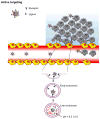Polymeric oncolytic adenovirus for cancer gene therapy
- PMID: 26453806
- PMCID: PMC4668934
- DOI: 10.1016/j.jconrel.2015.10.009
Polymeric oncolytic adenovirus for cancer gene therapy
Abstract
Oncolytic adenovirus (Ad) vectors present a promising modality to treat cancer. Many clinical trials have been done with either naked oncolytic Ad or combination with chemotherapies. However, the systemic injection of oncolytic Ad in clinical applications is restricted due to significant liver toxicity and immunogenicity. To overcome these issues, Ad has been engineered physically or chemically with numerous polymers for shielding the Ad surface, accomplishing extended blood circulation time and reduced immunogenicity as well as hepatotoxicity. In this review, we describe and classify the characteristics of polymer modified oncolytic Ad following each strategy for cancer treatment. Furthermore, this review concludes with the highlights of various polymer-coated Ads and their prospects, and directions for future research.
Keywords: Active targeting; Cancer gene therapy; Clinical trials; Oncolytic Ad/polymer hybrid vector; Oncolytic adenovirus; Systemic administration; Tumor microenvironment targeting.
Copyright © 2015 Elsevier B.V. All rights reserved.
Conflict of interest statement
The authors declare no competing financial interests.
Figures




Similar articles
-
pH-sensitive oncolytic adenovirus hybrid targeting acidic tumor microenvironment and angiogenesis.J Control Release. 2015 May 10;205:134-43. doi: 10.1016/j.jconrel.2015.01.005. Epub 2015 Jan 7. J Control Release. 2015. PMID: 25575865 Free PMC article.
-
Therapeutic targeting of chitosan-PEG-folate-complexed oncolytic adenovirus for active and systemic cancer gene therapy.J Control Release. 2013 Aug 10;169(3):257-65. doi: 10.1016/j.jconrel.2013.03.030. Epub 2013 Apr 4. J Control Release. 2013. PMID: 23562633
-
Efficient lung orthotopic tumor-growth suppression of oncolytic adenovirus complexed with RGD-targeted bioreducible polymer.Gene Ther. 2014 May;21(5):476-83. doi: 10.1038/gt.2014.18. Epub 2014 Mar 6. Gene Ther. 2014. PMID: 24598892
-
Recent advances in oncolytic adenovirus therapies for cancer.Curr Opin Virol. 2016 Dec;21:9-15. doi: 10.1016/j.coviro.2016.06.009. Epub 2016 Jul 2. Curr Opin Virol. 2016. PMID: 27379906 Free PMC article. Review.
-
Evolution of oncolytic adenovirus for cancer treatment.Adv Drug Deliv Rev. 2012 Jun 1;64(8):720-9. doi: 10.1016/j.addr.2011.12.011. Epub 2011 Dec 24. Adv Drug Deliv Rev. 2012. PMID: 22212901 Review.
Cited by
-
Overcoming the limitations of locally administered oncolytic virotherapy.BMC Biomed Eng. 2019 Jul 1;1:17. doi: 10.1186/s42490-019-0016-x. eCollection 2019. BMC Biomed Eng. 2019. PMID: 32903299 Free PMC article. Review.
-
"Double-punch" strategy for delivery of viral immunotherapy with prolonged tumor retention and enhanced transfection efficacy.J Control Release. 2021 Jan 10;329:328-336. doi: 10.1016/j.jconrel.2020.11.043. Epub 2020 Dec 2. J Control Release. 2021. PMID: 33278479 Free PMC article.
-
Optimizing Active Tumor Targeting Biocompatible Polymers for Efficient Systemic Delivery of Adenovirus.Cells. 2021 Jul 26;10(8):1896. doi: 10.3390/cells10081896. Cells. 2021. PMID: 34440666 Free PMC article.
-
Clinical Advances and Future Directions of Oncolytic Virotherapy for Head and Neck Cancer.Cancers (Basel). 2023 Nov 4;15(21):5291. doi: 10.3390/cancers15215291. Cancers (Basel). 2023. PMID: 37958464 Free PMC article. Review.
-
Innate immunity to adenovirus: lessons from mice.FEBS Lett. 2019 Dec;593(24):3461-3483. doi: 10.1002/1873-3468.13696. Epub 2019 Dec 8. FEBS Lett. 2019. PMID: 31769012 Free PMC article. Review.
References
-
- Popat K, McQueen K, Feeley TW. The global burden of cancer. Best Pract Res Clin Anaesthesiol. 2013;27:399–408. - PubMed
-
- Alemany R. Chapter four—design of improved oncolytic adenoviruses. Adv Cancer Res. 2012;115:93–114. - PubMed
-
- Cawood R, Hills T, Wong SL, Alamoudi AA, Beadle S, Fisher KD, Seymour LW. Recombinant viral vaccines for cancer. Trends Mol Med. 2012;18:564–574. - PubMed
-
- Harrop R, John J, Carroll MW. Recombinant viral vectors: cancer vaccines. Adv Drug Deliv Rev. 2006;58:931–947. - PubMed
Publication types
MeSH terms
Substances
Grants and funding
LinkOut - more resources
Full Text Sources
Other Literature Sources
Medical

